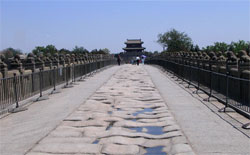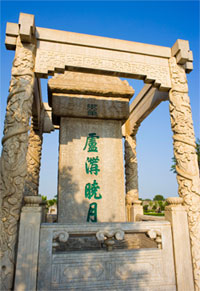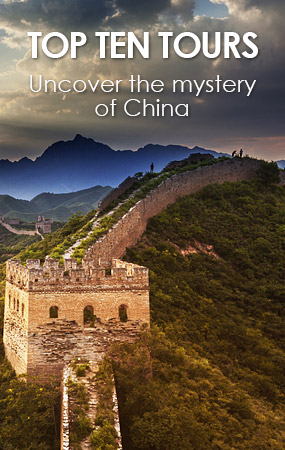Marco Polo Bridge(Lougu Bridge)
 The Lugu Bridge, also known as Marco Polo Bridge, spaning across the Yongding River, is situated 15km (9.32 miles) southwest of Tiananmen. The bridge is 235 m in length with 24 arches and 24 pillars of grey, in well presented marble blocks. Some of the arches along the bridge have been fastened with iron clamps to strengthen it and the bridge is closed to traffic to aid with preservation. Up the Yongding River, a dam has been built to create an artificial lake.
The Lugu Bridge, also known as Marco Polo Bridge, spaning across the Yongding River, is situated 15km (9.32 miles) southwest of Tiananmen. The bridge is 235 m in length with 24 arches and 24 pillars of grey, in well presented marble blocks. Some of the arches along the bridge have been fastened with iron clamps to strengthen it and the bridge is closed to traffic to aid with preservation. Up the Yongding River, a dam has been built to create an artificial lake.
The Marco Polo Bridge is considered an architectural masterpiece, built of solid granite, with a large central arch and ten smaller ones. Each of the ten arches are protected from the elements by triangular iron pillars.
Walking across the bridge, you’ll see 485 stone lions which is the Marco Polo Bridge famous for and each of them presents a unique appreance. Large stone slabs with calligraphy stand either end of the bridge. One apparently marks the rebuilding of the bridge and the other is an inscription by the emperor Qianlong. Stone elephants and lions have been placed to protect either end of the bridge.
 Next to the bridge is the Wanping Fortress dating back to the Ming Dynasty with bullet holes from 1937. Inside the fortress is the Memorial Museum of the Chinese People’s War of Resistance against Japan. It contains multimedia displays of the war. Parts of the Wanping City Wall can still be viewed, but most of it was destroyed in the 1950s. The Sculpture Garden covers an area of 22,500 sq meters and contains 38 bronze sculptures, showing the Chinese national spirit and heroism.
Next to the bridge is the Wanping Fortress dating back to the Ming Dynasty with bullet holes from 1937. Inside the fortress is the Memorial Museum of the Chinese People’s War of Resistance against Japan. It contains multimedia displays of the war. Parts of the Wanping City Wall can still be viewed, but most of it was destroyed in the 1950s. The Sculpture Garden covers an area of 22,500 sq meters and contains 38 bronze sculptures, showing the Chinese national spirit and heroism.
Travel Information
Address: Wanpingcheng, Fengtai District
Transport: Take subway Lines 1 and 10 to Gongzhufen Station and take Bus 624
Admission: RMB20

